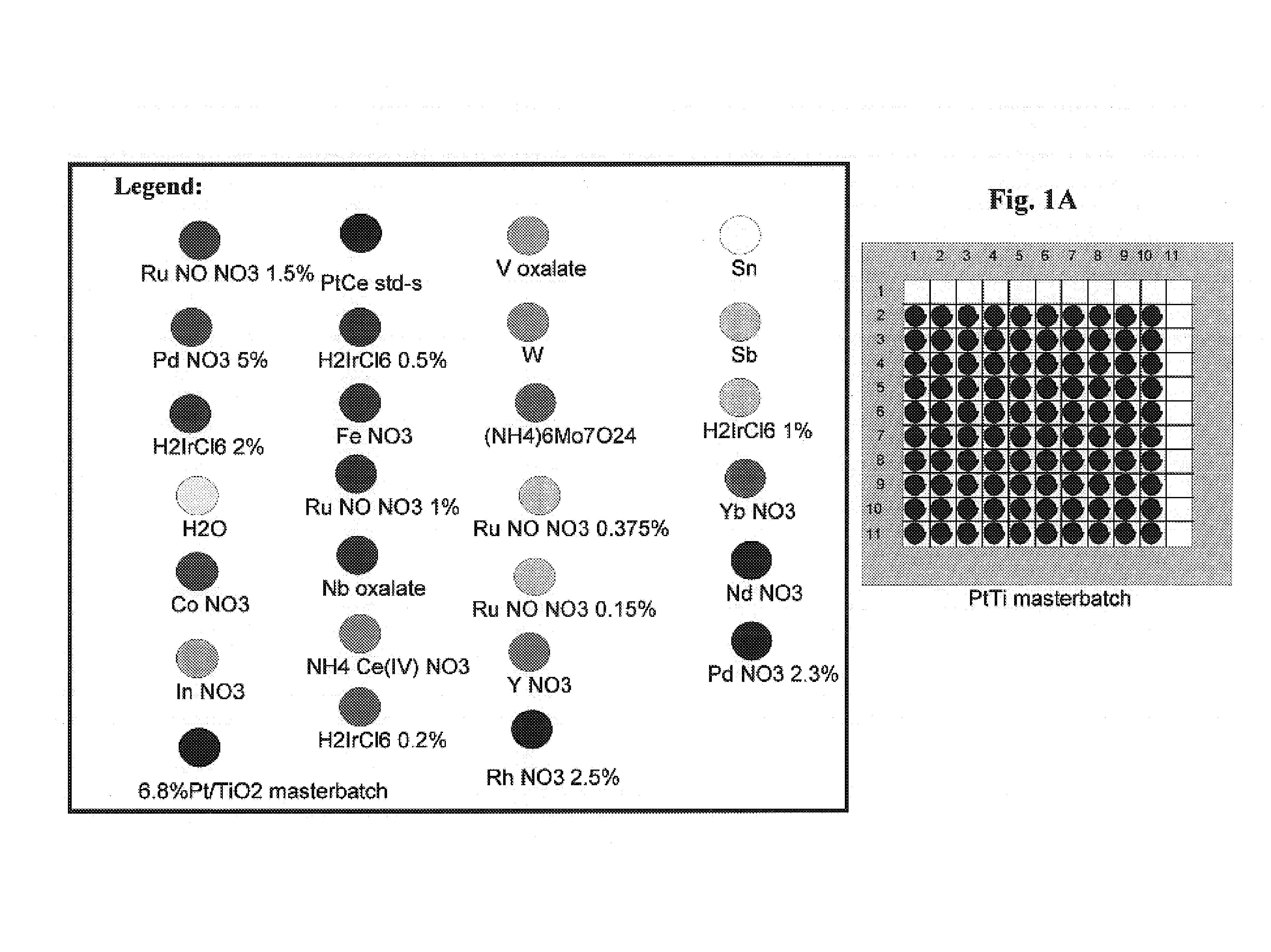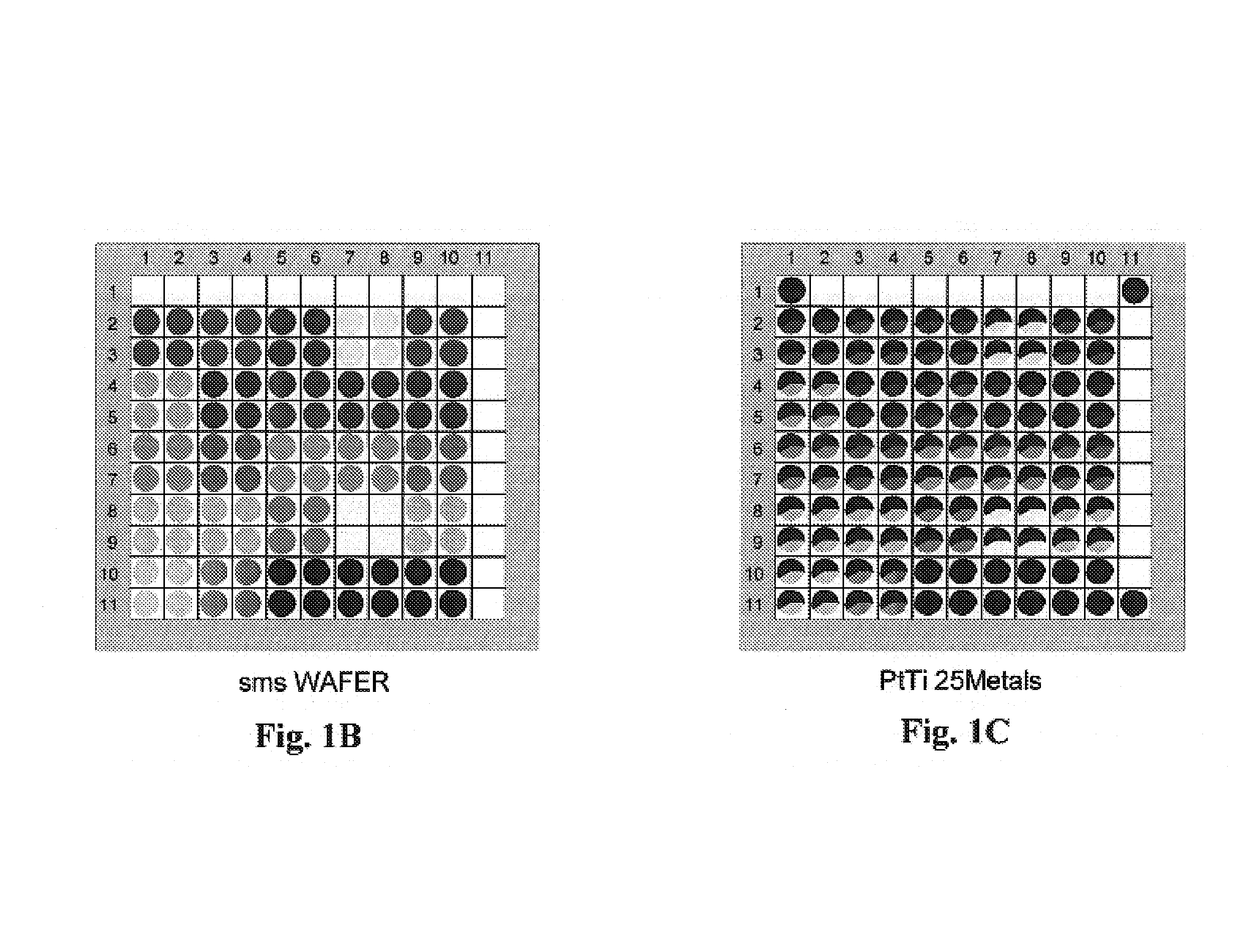Platinum-ruthenium containing catalyst formulations for hydrogen generation
a technology of hydrogen generation and catalyst formulation, which is applied in the field of methods and catalysts to achieve the effect of increasing the selectivity of hydrogen generation, high activity and high selectivity
- Summary
- Abstract
- Description
- Claims
- Application Information
AI Technical Summary
Benefits of technology
Problems solved by technology
Method used
Image
Examples
example 1
[0190]A 6.8% Pt / titania masterbatch was prepared by incipient wetness impregnation of 1000 mg titania powder (Degussa Aerolyst 7708, less than 100 mesh sieve fraction) with 1,300 μl of Pt(NH3)2(NO2)2 stock solution (5% Pt, STREM) and dried overnight at ambient, then at 80° C., then at 110° C.
[0191]500 mg of the 6.8% Pt / TiO2 masterbatch was slurried into 4 ml of EG / H2O / MEO 40 / 30 / 30 mixture and then slurry-dispensed onto a 3″ quartz wafer in two layers of 3 μl slurry each for a total dispense volume of 6 μl.
[0192]The Pt / TiO2 precoated wafer was then impregnated with 25 different metal solutions in squares of 2 by 2 wells by direct dispensing from metal stock solution vials onto the wafer at 2 μl dispense volume / well. The wafer was dried, calcined in air at 450° C. for 2 hours and then reduced in 5% H2 / Ar at 450° C. for 2 hours. See FIGS. 1A–1F.
[0193]The reduced library was then screened in scanning mass spectrometer (“SMS”) for WGS activity with a H2 / CO / CO2 / H2O mixed feed at 250° C., ...
example 2
[0194]A 3″ quartz wafer was precoated with TiO2, CeO2 and ZrO2 carriers by slurry dispensing (Degussa Aerolyst 7711 / Degussa P25 70:30 titania mix), (Aldrich ceria 21,157-5) and (Norton XZ16052 / MEI FZO923 70:30 zirconia mix) onto the wafer.
[0195]The carrier-precoated wafer was dried and then impregnated with Ru, Ce, Fe gradients. The Ru, Ce, Fe gradients were premixed in a microtiter plate by dilution of Ru nitrosyl nitrate stock solution (1.5% Ru), Ce nitrate stock solution (1M Ce) and Fe nitrate stock solution (1M Fe) with water and transferred from the microtiter plate to the wafer by Cavro dispensing (3 μl dispense volume per well). The wafer was dried and then impregnated with Ti gradients. The Ti gradients were premixed in a microtiter plate by dilution of ammonium titanyl oxalate stock solution (1M Ti) with water and then transferred from the microtiter plate to the wafer by Cavro dispensing (3 μl dispense volume per well). The wafer was dried and then impregnated with Pt grad...
example 3
[0197]A 4″ quartz wafer was precoated with zirconia carrier by repeated slurry dispensing zirconia (ZrO2 Norton XZ16052 / MEI FZO923 70:30 mixture, 2×4 μl for a total of 8 μl zirconia slurry, 1 g ZrO2 mix slurried in 4 ml EG / H2O 1:1) onto the wafer.
[0198]The zirconia carrier-precoated wafer was dried and then impregnated with Pt by Cavro dispensing from a Pt(NH3)2(NO2)2 stock solution vial (2.5% Pt) directly onto the wafer by 3 μl dispense volume / well. Six internal standards were spotted into 6 first row / last column wells (4 μl zirconia slurry+3 μl 2.5% Pt solution). The wafer was dried for 10 minutes at 70° C.
[0199]The wafer was then impregnated with Co—Ru and Ru—Pt gradients by Cavro dispensing from Co nitrate (0.5M Co), Ru nitrosyl nitrate (1% Ru) and Pt(NH3)2(NO2)2 (5% Pt) stock solution vials to a microtiter plate followed by transferring replicas of the 8-point and 7-point gradients onto the wafer at 3 μl dispense volume / well. The wafer was dried and then impregnated with FeCo b...
PUM
| Property | Measurement | Unit |
|---|---|---|
| temperature | aaaaa | aaaaa |
| temperature | aaaaa | aaaaa |
| temperature | aaaaa | aaaaa |
Abstract
Description
Claims
Application Information
 Login to View More
Login to View More - R&D
- Intellectual Property
- Life Sciences
- Materials
- Tech Scout
- Unparalleled Data Quality
- Higher Quality Content
- 60% Fewer Hallucinations
Browse by: Latest US Patents, China's latest patents, Technical Efficacy Thesaurus, Application Domain, Technology Topic, Popular Technical Reports.
© 2025 PatSnap. All rights reserved.Legal|Privacy policy|Modern Slavery Act Transparency Statement|Sitemap|About US| Contact US: help@patsnap.com



